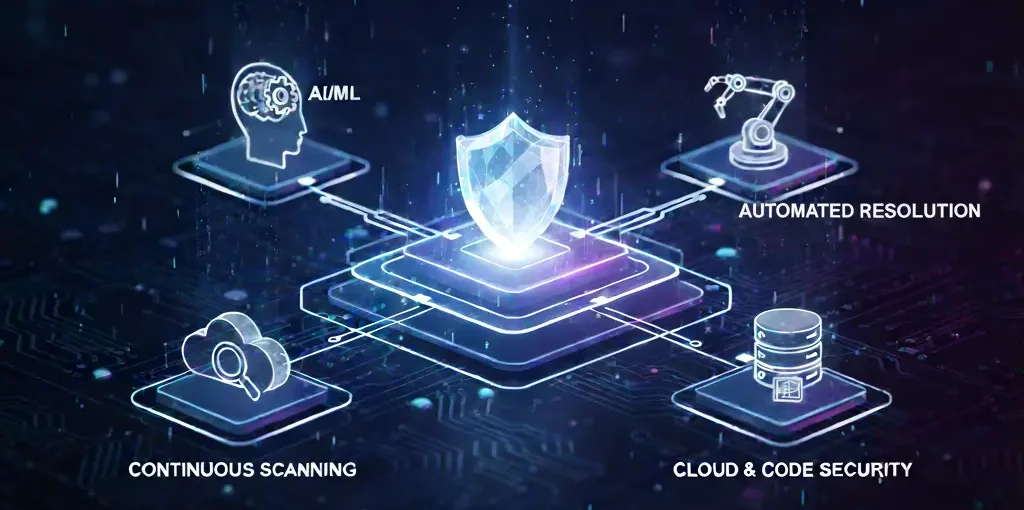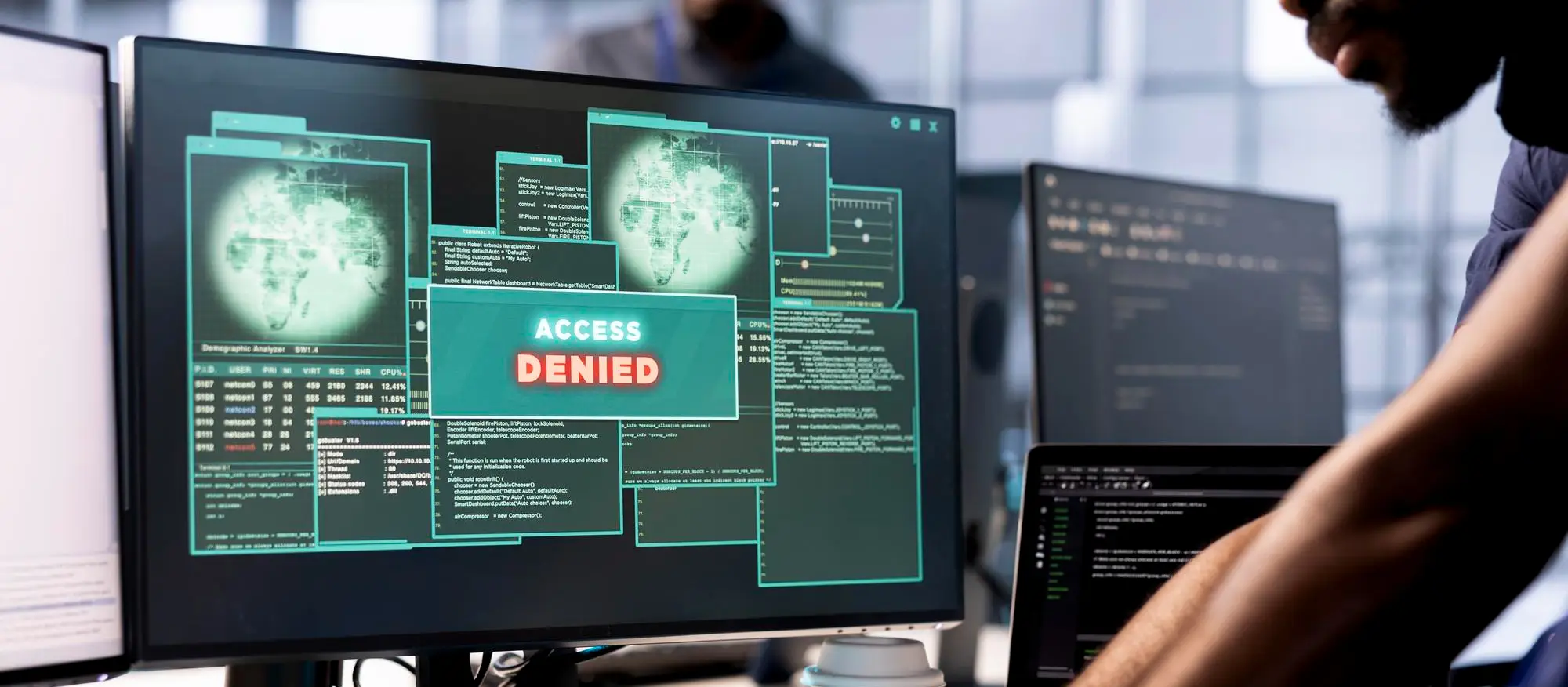At Experion Technologies, we empower enterprises to strengthen digital trust, compliance, and innovation through intelligent, automated, and future-ready vulnerability management software solutions.
As digital transformation accelerates, organizations face an expanding attack surface across cloud, network, and application environments. Every new integration or deployment introduces potential exposure. According to recent studies, the average global cost of a data breach in 2025 has exceeded $5 million, and nearly 60% of these incidents stem from unpatched vulnerabilities.
This reality makes vulnerability management in software a strategic priority for every CXO. It is not just a cybersecurity function but a business-critical capability that aligns with governance, innovation, and operational continuity, ensuring that digital growth is never compromised by security risk.
Understanding Vulnerability Management Software

From Detection to Intelligent Defense
Vulnerability management software enables organizations to identify, assess, prioritize, and remediate security weaknesses across their digital ecosystem. It acts as the central nervous system of cybersecurity operations, continuously sensing, analyzing, and responding to potential risks.
Unlike traditional reactive approaches or point-in-time audits, the best vulnerability management software is proactive, contextual, and driven by risk intelligence. It integrates seamlessly with DevSecOps pipelines, supports continuous monitoring, and ensures security is embedded in every stage of the digital lifecycle.
A mature risk based vulnerability management software program not only resolves vulnerabilities but also enhances compliance readiness, operational resilience, and long-term business continuity.
Visibility is the foundation of defense, you can’t protect what you can’t see.
Partner with Experion to gain complete visibility into your attack surface
The Vulnerability Management Lifecycle

A Continuous Cycle of Awareness, Action, and Assurance
A comprehensive software for vulnerability management operates as a continuous loop, identifying, analyzing, remediating, and validating exposures across diverse IT environments.
- Discovery — Seeing the Unseen
Security begins with visibility. Discovery builds an accurate and dynamic inventory of assets across on-premises, cloud, and hybrid environments.
Experion’s network vulnerability management software uses automated scanning and continuous asset intelligence to detect unauthorized systems, shadow IT, and configuration drift.
- Assessment — Understanding Exposure
Once assets are identified, vulnerability assessment determines weaknesses within applications, networks, and configurations. Experion combines static, dynamic, and API testing for comprehensive insight. The result is not just a list of issues but a risk-based vulnerability map aligned with business priorities.
- Prioritization — Aligning Security with Value
Large enterprises face thousands of vulnerabilities, but not all carry equal risk. Experion’s risk based vulnerability management software uses CVSS scores, asset criticality, and threat intelligence to prioritize remediation for maximum business impact.
- Remediation — Executing with Precision
Remediation turns analysis into action. Our vulnerability management software integrates with ITSM systems, enabling automated workflows between security and IT operations. When immediate patching isn’t possible, we apply virtual patching and configuration hardening to reduce risk without disrupting uptime.
- Validation — Ensuring Every Fix Holds
Validation ensures vulnerabilities are truly resolved. Through re-scanning, testing, and CI/CD integration, Experion embeds assurance into deployment processes, ensuring compliance and risk maturity remain intact.
- Continuous Monitoring — Achieving Adaptive Resilience
True resilience is continuous. With AI-driven analytics and observability dashboards, our vulnerability management in software solutions monitor evolving threats, configuration drift, and compliance in real time, turning security into a predictive capability.
Resilience is not a milestone. It’s a state of awareness.
Connect with Experion to establish continuous threat observability
The Business Value of Vulnerability Management Software
- Security as a Catalyst for Confidence and Growth
Forward-looking enterprises view vulnerability management software not just as protection but as a strategic enabler of growth, customer trust, and compliance maturity.
- Fewer Incidents, Greater Uptime
Proactive detection and remediation reduce the likelihood of breaches and ensure uninterrupted services. Higher uptime translates to improved business continuity, reliability, and customer confidence, critical metrics for digital-first organizations.
- Cost Efficiency
Fixing vulnerabilities early in the lifecycle costs exponentially less than post-incident recovery. Experion’s software for vulnerability management automates scanning and patching to reduce recovery costs, regulatory fines, and operational disruptions.
- Regulatory Compliance and Audit Readiness
Our vulnerability management software supports compliance across frameworks such as ISO 27001, GDPR, HIPAA, and PCI DSS. By integrating control validation and reporting, enterprises can achieve continuous audit readiness and demonstrate accountability.
- Trust and Reputation
Every remediated vulnerability strengthens credibility. A visible, proactive security posture reassures customers, investors, and regulators that data protection is a core business commitment.
- Accelerated Innovation
With security integrated into DevSecOps pipelines, organizations can innovate confidently. Experion’s network vulnerability management software helps development teams release faster while maintaining compliance and integrity.
Connect with Experion to transform security into a business growth engine
Best Practices for Vulnerability Management
Building a Culture of Continuous Security
A successful vulnerability management strategy is not defined by how many vulnerabilities are found, but by how effectively an organization can detect, prioritize, and resolve them. For CXOs, it’s about turning a technical process into a repeatable business discipline, one that combines automation, intelligence, and accountability.
Here are key best practices that drive resilient, enterprise-scale vulnerability management programs:
- Automate Scanning, Prioritization, and Remediation
Manual vulnerability management cannot match the pace of modern IT change. Enterprises today need automation across every phase, from discovery to remediation.
Automated vulnerability management systems continuously scan for weaknesses, rank their severity based on context, and initiate patch workflows or configuration updates without manual intervention.
Experion’s approach uses AI-powered orchestration and integrated patch management pipelines to accelerate response times and minimize exposure windows.
- Integrate Vulnerability Management into DevSecOps and CI/CD Pipelines
Security should move at the same speed as innovation. Embedding vulnerability management (VM) into DevSecOps ensures that every build, commit, and deployment passes through automated security checks.
In continuous integration and delivery (CI/CD) environments, Experion helps clients integrate automated scanners and static analysis tools that test code for vulnerabilities before release, enabling “secure by default” delivery at scale.
- Use Risk-Based Prioritization Instead of Severity Alone
Not all vulnerabilities pose equal risk. A high-severity issue on a test server is less critical than a medium-severity flaw in a production payment system.
Risk-based vulnerability management combines severity scores with exploitability, business context, and asset importance to determine what matters most. This approach allows security teams to allocate resources intelligently, protecting business-critical systems first while maintaining operational efficiency.
- Conduct Regular Rescans and Trend Analysis
Security is a moving target. Continuous vulnerability management means verifying that previously remediated issues remain closed, and that new vulnerabilities are identified quickly.
Trend analysis across scan data helps leaders understand patterns, whether vulnerabilities stem from configuration gaps, outdated components, or recurring process failures. These insights enable long-term improvement and inform strategic decision-making.
- Establish Governance, SLAs, and Accountability
Vulnerability management thrives on clear ownership and measurable outcomes.
Enterprises should establish governance frameworks that define Service Level Agreements (SLAs) for remediation based on risk level, for example, critical vulnerabilities fixed within 48 hours.
Experion’s governance model brings together security, IT operations, and compliance teams under a single reporting structure, ensuring accountability at every level.
- Train IT and Development Teams Continuously
Technology alone cannot solve the human gap. Building awareness of secure configuration, patch management, and secure coding is essential for sustainable progress.
Through Experion’s cybersecurity training and coaching programs, organizations cultivate teams that not only respond to vulnerabilities but actively prevent them through smarter design and disciplined operations.
In essence, effective vulnerability management depends on automation, integration, and education, three pillars that enable enterprises to manage risk as a living, evolving practice.
The cost of prevention is always lower than the price of recovery.
Connect with Experion to implement best-in-class vulnerability management practices
Trends and Innovations in Vulnerability Management Software

Adapting to an Intelligent, Cloud-Native Security Landscape
The world of vulnerability management software is evolving rapidly. As organizations move toward hybrid and cloud-native architectures, the velocity of change has created new challenges in maintaining visibility, control, and compliance. Traditional tools can no longer keep pace with dynamic, containerized environments, today’s landscape demands intelligent, automated, and adaptive software for vulnerability management that learns, responds, and scales continuously.
Below are the key innovations shaping the next generation of risk based vulnerability management software and redefining how enterprises approach cyber defense.
- AI and Machine Learning for Precision and Efficiency
Artificial Intelligence (AI) and Machine Learning (ML) are transforming vulnerability management in software by improving accuracy, prioritization, and efficiency. Through advanced data analytics, AI can identify false positives, predict exploitability, and recommend optimized remediation strategies.
At Experion, we embed AI-driven analytics into our vulnerability management dashboards, allowing security teams to focus on the vulnerabilities that matter most, reducing noise while strengthening resilience and response precision.
- Self-Healing Systems and Automated Remediation
The emergence of self-healing infrastructure marks a significant milestone in vulnerability management software innovation. Modern enterprises are moving toward systems that autonomously detect and resolve vulnerabilities in real time. Using orchestration, automation, and Infrastructure-as-Code (IaC), vulnerabilities can be patched or isolated within minutes instead of weeks.
Experion’s automation-first frameworks integrate risk based vulnerability management software with IT operations to ensure that remediation is not a reactive process but an embedded system capability, accelerating time-to-fix and improving uptime.
- Real-Time Continuous Scanning for Dynamic Environments
Static, point-in-time scans are no longer effective in cloud and microservices ecosystems, where assets are ephemeral and constantly evolving. Continuous scanning provides the agility required to detect and respond to threats in real time.
Experion’s network vulnerability management software continuously monitors workloads, APIs, and containers, ensuring every new instance is evaluated the moment it’s created, closing gaps before attackers can exploit them.
- Container and Kubernetes Vulnerability Management
As enterprises adopt containerization and Kubernetes orchestration, securing these environments has become a top priority. Vulnerability management in software now extends beyond code to include container images, registries, and orchestration pipelines.
Experion integrates container scanning tools directly into DevSecOps workflows, providing visibility across build, deployment, and runtime stages. This proactive approach ensures containers are secure before deployment and remain compliant throughout their lifecycle.
- Integration with Threat Intelligence and Supply Chain Security
The best vulnerability management software now merges with threat intelligence platforms to correlate vulnerabilities with real-world exploits. This allows security teams to prioritize based on actual attack likelihood rather than static severity scores.
Additionally, Software Bill of Materials (SBOM) management has emerged as a critical component for securing software supply chains. Experion helps enterprises link vulnerability data with real-time threat feeds and SBOM tracking, offering end-to-end visibility across dependencies and third-party components.
- Infrastructure-as-Code (IaC) Vulnerability Checks
Infrastructure-as-Code has revolutionized how organizations build cloud infrastructure, but it also introduces risks if misconfigured. Automated IaC vulnerability scanning tools evaluate Terraform, CloudFormation, and Kubernetes manifests for compliance before deployment.
Experion’s software for vulnerability management integrates IaC checks within CI/CD pipelines, ensuring that every environment, from development to production, is secure from inception.
Challenges in Vulnerability Management Software

Why Many Programs Fall Short and How to Fix Them?
Despite increased investments in cybersecurity, many organizations still struggle to achieve consistent results from their vulnerability management software initiatives. The reasons are rarely about technology alone, they often stem from misalignment, lack of automation, and limited visibility at scale.
- Tool Fragmentation
Enterprises frequently rely on multiple scanners and siloed tools that fail to communicate effectively. This creates data redundancy, inconsistent reporting, and missed vulnerabilities. Instead of managing risks, teams end up managing dashboards. The best vulnerability management software integrates all discovery and remediation workflows into one unified platform.
- Alert Fatigue
Automated scanning tools can generate thousands of alerts daily, many of which are false positives. Without intelligent filtering, security teams face alert fatigue, missing the truly critical risks that demand immediate attention.
- Legacy and Technical Debt
Aging infrastructure and unsupported software increase exposure. These systems, often too critical to replace, become permanent weak links in the security chain, requiring specialized software for vulnerability management to isolate and mitigate risks effectively.
- Remediation Bottlenecks
Security teams often identify vulnerabilities faster than IT teams can patch them. Without proper SLA tracking, ownership assignment, or automation, unresolved issues accumulate. Risk based vulnerability management software bridges this gap by automating ticketing, prioritization, and escalation.
- Cloud Complexity
Multi-cloud deployments, containers, and ephemeral workloads add new layers of risk. Traditional tools struggle to manage this dynamism. Modern network vulnerability management software adapts in real time, tracking vulnerabilities across APIs, containers, and hybrid networks.
- Cultural Silos
The biggest challenge is cultural. When security is viewed as solely the IT team’s concern, accountability gaps arise. Sustainable programs succeed when leadership, DevOps, and cybersecurity teams share ownership of vulnerability reduction.
Experion Technologies addresses these challenges by creating intelligent, unified, and automated vulnerability management software ecosystems. Our solutions integrate discovery, assessment, and remediation into a single workflow, contextualized with business priorities and governed by measurable KPIs. This transforms vulnerability management from a technical task into a continuous governance capability that enhances resilience and compliance.
The Future: From Reactive Defense to Predictive Resilience
These innovations represent a paradigm shift in vulnerability management software, from manual response to predictive intelligence, from visibility to foresight, and from compliance to resilience. As AI, automation, and cloud-native technologies converge, organizations can move from reactive vulnerability patching to continuous, proactive risk elimination.
By embracing intelligent, adaptive, and automated vulnerability management systems, enterprises can not only identify risks but neutralize them in real time, transforming security from a defensive shield into a strategic enabler of trust and innovation.
Case Study: Automated Vulnerability Management with Experion Technologies
Scaling Security Through Automation and Governance
A global engineering and construction enterprise faced a rising attack surface, fragmented tools, and mounting compliance pressure. Their vulnerability data was scattered, creating blind spots and inefficiencies across security and IT operations.
The Challenge
- Multiple scanners generating redundant data without centralized visibility.
- Irregular patching cadence and inconsistent vulnerability remediation cycles.
- Manual, time-consuming workflows that delayed response to high-severity risks.
Experion’s Approach
- Deployed a hybrid vulnerability management software solution combining automation with human oversight.
- Integrated ITIL-aligned workflows to orchestrate scanning, ticketing, and patching.
- Hardened infrastructure through CIS benchmark alignment, TLS/SSL audits, and secure configuration management.
- Established real-time compliance dashboards and continuous reporting mechanisms.
The Results
- 70% reduction in vulnerabilities within one year.
- Accelerated remediation cycles supported by SLA-based governance.
- Expanded coverage from endpoints to applications and networks.
- Improved audit readiness and reduced manual compliance effort.
Through this engagement, Experion transformed a fragmented process into a centralized, data-driven security governance model, reinforcing trust, operational agility, and measurable risk reduction.
Experion’s Cybersecurity & Vulnerability Management Capabilities

Securing Digital Trust Through Intelligent Engineering
At Experion Technologies, we deliver intelligent cybersecurity ecosystems that integrate automation, analytics, and governance to protect global enterprises operating in complex digital environments.
Our key offerings include:
- Vulnerability Management and Continuous Monitoring
- Threat Detection and Response (TDR)
- Cloud Security and DevSecOps Integration
- Compliance and Risk Governance (ISO 27001, NIST, SOC 2, GDPR, HIPAA)
- Identity and Access Management (IAM)
- Incident Response and Security Automation
By combining AI-driven automation, deep domain expertise, and engineering excellence, we help organizations transform cybersecurity from a cost center into a competitive advantage. Our risk based vulnerability management software not only reduces exposure but accelerates innovation by aligning security with business goals.
Security, when engineered intelligently, becomes a catalyst for growth.
Connect with Experion to build a resilient cybersecurity foundation
From Compliance to Confidence
Turning Vulnerability Management into a Strategic Enabler
Vulnerability management has evolved beyond compliance checklists. Today, it drives trust, agility, and innovation. Organizations that adopt automated, risk based vulnerability management software gain a competitive edge through faster response times, reduced exposure, and increased confidence among customers and regulators.
At Experion Technologies, we partner with enterprises to move beyond reactive protection. Our intelligent, automated systems learn continuously, adapting to new threats while maintaining compliance. In the digital era, resilience is not just protection, it is progress.
Key Takeaways
- Vulnerability management is a continuous discipline, not a one-time audit.
- Unified visibility and automation drive measurable, sustainable outcomes.
- Cultural alignment across teams is as critical as deploying the right tools.
- Software for vulnerability management enhances compliance, uptime, and customer trust.
- Risk based vulnerability management software ensures effort is spent where it matters most.
- Network vulnerability management software delivers visibility across endpoints, clouds, and hybrid environments.
- Experion Technologies enables enterprises to reduce risk, achieve compliance, and strengthen digital resilience through intelligent, automated vulnerability management solutions.
Connect with Experion Technologies today to future-proof your cybersecurity strategy and turn resilience into your greatest advantage.

